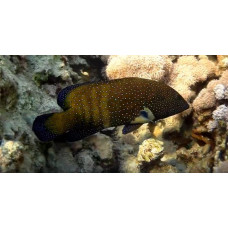Latin name
Cephalopholis argus
Other name
Roi, bluespotted grouper, and celestial grouper.
Identification
The body of the bluespotted grouper is elongated, massive, somewhat compressed at the sides, cylindrical in shape, covered laterally with ctenoid scales. The body height is 2.7-3.2 times the standard body length. Head length exceeds body length and is 2.4-2.7 times shorter than body length. The interorbital space is flat or slightly convex. Eyes small, their diameter considerably less than the length of the snout. The preoperculum is rounded, with serrated edges in juveniles and smooth in adults; the lower edge is fleshy. The upper jaw is covered with scales, the tip of which extends well beyond the vertical line passing through the posterior margin of the eye. The upper part of the first gill arch has 9-11 and the lower part 17-19 gill stamens. Both jaws have small fang-like teeth in the anterior part; there are teeth on the coulter. There are 46-51 scales on the lateral line. There are 95-110 rows of scales along the lateral line, the scales on the sides of the body are coarse with a few additional scales.
Features of fish fins
The dorsal fin has 10 hard and 15-17 soft rays; there are no elongated rays. The membranes between the hard rays are truncated. The anal fin has 3 hard and 9 soft rays. Pectoral fins have 16-18 soft rays. The pelvic fins are shorter than the pectoral fins, their ends do not reach the anus. The caudal fin is rounded.
Fish colouring
Body and head dark brown, covered with numerous small blue eye-shaped spots with a black border. There are 5-6 pale cross stripes along the back of the body. There is a large pale area on the thorax. Posterior margin of pectoral and pelvic fins usually with a narrow white border. Distal margins of pectoral fins sometimes dark maroon. Tops of truncated dorsal fin membranes golden orange.
Distribution
Widely distributed species. Found from the Red Sea to southern Africa, along the coast of South and Southeast Asia, and further east to French Polynesia and the Pitcairn Islands. In the Pacific Ocean it is found as far north as Japan and as far south as Australia (Lord Howe Island). Introduced into the Hawaiian Islands.
Habitat
A marine tropical, reef-associated species. Does not migrate. Depth range 0 to 40 m, usually 1 to 15 m.
Size
The maximum body length of these fish is 60 centimeters, usually up to 40 centimeters.
Behavior
Adults inhabit the benthic and benthopelagic in a variety of coral habitats from tide pools to depths of at least 40 meters. They prefer the reef zone from 1 to 10 m. Juveniles prefer shallow, sheltered coral thickets. Adults occur in social groups of up to 12 adults, including 1 dominant male, and each group occupies a defined territory (up to 2,000 square meters) defended by a territorial male and subdivided into secondary territories, each inhabited by a single female. Sometimes they may be solitary.
Food and feeding habits
Adults feed mainly on fish (75-95%) and to a lesser extent on crustaceans. In the Red Sea they feed in the early morning and late evening, while in Madagascar they seem to feed more frequently at night.
Reproduction
In Micronesia, spawning is usually territorial and occurs at dusk. During courtship, both sexes are dark except for a white keyhole-shaped spot in the center of the body.
Fishing
Bluespotted grouper is important to artisanal fisheries throughout the Indo-West Pacific region and is often caught by hook and line, spear and trap.
Relationship with a person
They can be found in live fish markets in Hong Kong. There have been reports of ciguatera poisoning.
| Classification | |
| Phylum | Chordata |
| Class | Actinopterygii |
| Squad | Perciformes |
| Family | Serranidae |
| Genus | Cephalopholis |
| Species | C. argus |
| Features | |
| Conservation status | Least Concern |
| Habitat | Pelagic |
| Life span, years | No information |
| Maximum body weight, kg | No information |
| Maximum length, cm | 60 |
| Sailing speed, m/s | No information |
| Threat to people | Not edible |
| Way of eating | Planktonophage |
Bluespotted grouper
Tags: peacock hind



